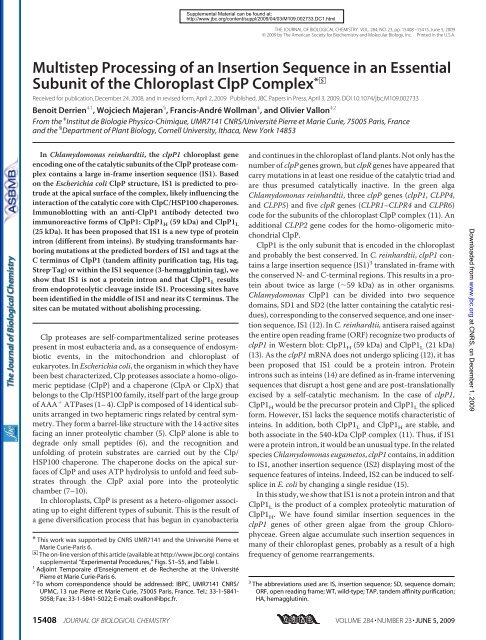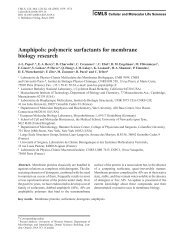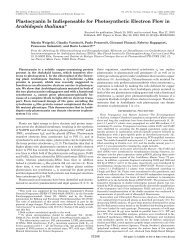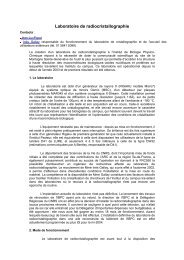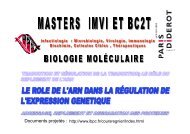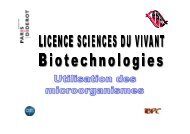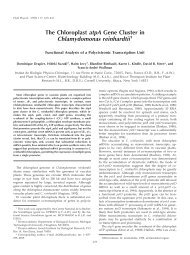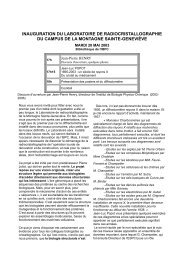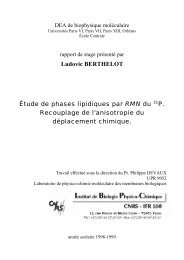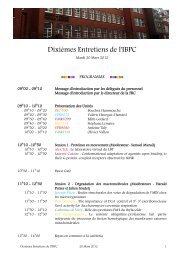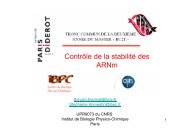Derrien B, Majeran W, Wollman FA, Vallon O - Ibpc
Derrien B, Majeran W, Wollman FA, Vallon O - Ibpc
Derrien B, Majeran W, Wollman FA, Vallon O - Ibpc
You also want an ePaper? Increase the reach of your titles
YUMPU automatically turns print PDFs into web optimized ePapers that Google loves.
Multistep Processing of an Insertion Sequence in an Essential<br />
Subunit of the Chloroplast ClpP Complex *□S<br />
Received for publication, December 24, 2008, and in revised form, April 2, 2009 Published, JBC Papers in Press, April 3, 2009, DOI 10.1074/jbc.M109.002733<br />
Benoit <strong>Derrien</strong> ‡1 , Wojciech <strong>Majeran</strong> § , Francis-André <strong>Wollman</strong> ‡ , and Olivier <strong>Vallon</strong> ‡2<br />
From the ‡ Institut de Biologie Physico-Chimique, UMR7141 CNRS/Université Pierre et Marie Curie, 75005 Paris, France<br />
and the § Department of Plant Biology, Cornell University, Ithaca, New York 14853<br />
In Chlamydomonas reinhardtii, the clpP1 chloroplast gene<br />
encoding one of the catalytic subunits of the ClpP protease complex<br />
contains a large in-frame insertion sequence (IS1). Based<br />
on the Escherichia coli ClpP structure, IS1 is predicted to protrude<br />
at the apical surface of the complex, likely influencing the<br />
interaction of the catalytic core with ClpC/HSP100 chaperones.<br />
Immunoblotting with an anti-ClpP1 antibody detected two<br />
immunoreactive forms of ClpP1: ClpP1 H (59 kDa) and ClpP1 L<br />
(25 kDa). It has been proposed that IS1 is a new type of protein<br />
intron (different from inteins). By studying transformants harboring<br />
mutations at the predicted borders of IS1 and tags at the<br />
C terminus of ClpP1 (tandem affinity purification tag, His tag,<br />
StrepTag) or within the IS1 sequence (3-hemagglutinin tag), we<br />
show that IS1 is not a protein intron and that ClpP1 L results<br />
from endoproteolytic cleavage inside IS1. Processing sites have<br />
been identified in the middle of IS1 and near its C terminus. The<br />
sites can be mutated without abolishing processing.<br />
Clp proteases are self-compartmentalized serine proteases<br />
present in most eubacteria and, as a consequence of endosymbiotic<br />
events, in the mitochondrion and chloroplast of<br />
eukaryotes. In Escherichia coli, the organism in which they have<br />
been best characterized, Clp proteases associate a homo-oligomeric<br />
peptidase (ClpP) and a chaperone (ClpA or ClpX) that<br />
belongs to the Clp/HSP100 family, itself part of the large group<br />
of AAA ATPases (1–4). ClpP is composed of 14 identical subunits<br />
arranged in two heptameric rings related by central symmetry.<br />
They form a barrel-like structure with the 14 active sites<br />
facing an inner proteolytic chamber (5). ClpP alone is able to<br />
degrade only small peptides (6), and the recognition and<br />
unfolding of protein substrates are carried out by the Clp/<br />
HSP100 chaperone. The chaperone docks on the apical surfaces<br />
of ClpP and uses ATP hydrolysis to unfold and feed substrates<br />
through the ClpP axial pore into the proteolytic<br />
chamber (7–10).<br />
In chloroplasts, ClpP is present as a hetero-oligomer associating<br />
up to eight different types of subunit. This is the result of<br />
a gene diversification process that has begun in cyanobacteria<br />
* This work was supported by CNRS UMR7141 and the Université Pierre et<br />
Marie Curie-Paris 6.<br />
□S The on-line version of this article (available at http://www.jbc.org) contains<br />
supplemental “Experimental Procedures,” Figs. S1–S5, and Table I.<br />
1 Adjoint Temporaire d’Enseignement et de Recherche at the Université<br />
Pierre et Marie Curie-Paris 6.<br />
2 To whom correspondence should be addressed: IBPC, UMR7141 CNRS/<br />
UPMC, 13 rue Pierre et Marie Curie, 75005 Paris, France. Tel.: 33-1-5841-<br />
5058; Fax: 33-1-5841-5022; E-mail: ovallon@ibpc.fr.<br />
Supplemental Material can be found at:<br />
http://www.jbc.org/content/suppl/2009/04/03/M109.002733.DC1.html<br />
THE JOURNAL OF BIOLOGICAL CHEMISTRY VOL. 284, NO. 23, pp. 15408–15415, June 5, 2009<br />
© 2009 by The American Society for Biochemistry and Molecular Biology, Inc. Printed in the U.S.A.<br />
and continues in the chloroplast of land plants. Not only has the<br />
number of clpP genes grown, but clpR genes have appeared that<br />
carry mutations in at least one residue of the catalytic triad and<br />
are thus presumed catalytically inactive. In the green alga<br />
Chlamydomonas reinhardtii, three clpP genes (clpP1, CLPP4,<br />
and CLPP5) and five clpR genes (CLPR1–CLPR4 and CLPR6)<br />
code for the subunits of the chloroplast ClpP complex (11). An<br />
additional CLPP2 gene codes for the homo-oligomeric mitochondrial<br />
ClpP.<br />
ClpP1 is the only subunit that is encoded in the chloroplast<br />
and probably the best conserved. In C. reinhardtii, clpP1 contains<br />
a large insertion sequence (IS1) 3 translated in-frame with<br />
the conserved N- and C-terminal regions. This results in a protein<br />
about twice as large (59 kDa) as in other organisms.<br />
Chlamydomonas ClpP1 can be divided into two sequence<br />
domains, SD1 and SD2 (the latter containing the catalytic residues),<br />
corresponding to the conserved sequence, and one insertion<br />
sequence, IS1 (12). In C. reinhardtii, antisera raised against<br />
the entire open reading frame (ORF) recognize two products of<br />
clpP1 in Western blot: ClpP1 H (59 kDa) and ClpP1 L (21 kDa)<br />
(13). As the clpP1 mRNA does not undergo splicing (12), it has<br />
been proposed that IS1 could be a protein intron. Protein<br />
introns such as inteins (14) are defined as in-frame intervening<br />
sequences that disrupt a host gene and are post-translationally<br />
excised by a self-catalytic mechanism. In the case of clpP1,<br />
ClpP1 H would be the precursor protein and ClpP1 L the spliced<br />
form. However, IS1 lacks the sequence motifs characteristic of<br />
inteins. In addition, both ClpP1 L and ClpP1 H are stable, and<br />
both associate in the 540-kDa ClpP complex (11). Thus, if IS1<br />
were a protein intron, it would be an unusual type. In the related<br />
species Chlamydomonas eugametos, clpP1 contains, in addition<br />
to IS1, another insertion sequence (IS2) displaying most of the<br />
sequence features of inteins. Indeed, IS2 can be induced to selfsplice<br />
in E. coli by changing a single residue (15).<br />
In this study, we show that IS1 is not a protein intron and that<br />
ClpP1 L is the product of a complex proteolytic maturation of<br />
ClpP1 H. We have found similar insertion sequences in the<br />
clpP1 genes of other green algae from the group Chlorophyceae.<br />
Green algae accumulate such insertion sequences in<br />
many of their chloroplast genes, probably as a result of a high<br />
frequency of genome rearrangements.<br />
3 The abbreviations used are: IS, insertion sequence; SD, sequence domain;<br />
ORF, open reading frame; WT, wild-type; TAP, tandem affinity purification;<br />
HA, hemagglutinin.<br />
15408 JOURNAL OF BIOLOGICAL CHEMISTRY VOLUME 284•NUMBER 23•JUNE 5, 2009<br />
Downloaded from www.jbc.org at CNRS, on December 1, 2009
EXPERIMENTAL PROCEDURES<br />
Strains and Culture Conditions—Our C. reinhardtii wildtype<br />
(WT) strain WTS34 mt is derived from the 137c background.<br />
Other algal strains were kindly provided by Pierre Cardol<br />
(Liège University, Liège, Belgium). All strains were grown in<br />
Tris acetate/phosphate medium under constant illumination<br />
(5–10 microeinsteins m 2 s 1 ) at 25 °C (16).<br />
ClpP1 Mutagenesis—A genomic fragment corresponding to<br />
nucleotides 16972–20083 of the chloroplast genome (Gen-<br />
Bank TM accession number BK000554) and encompassing the<br />
C-terminal end of the petB coding region and the trnL, clpP1,<br />
trnW, and trnS genes was PCR-amplified using Chlamydomonas<br />
total DNA as template and oligonucleotide primers<br />
SBamHI and REVA (see supplemental “Experimental Procedures”<br />
for oligonucleotide sequences and details on site-directed<br />
mutagenesis). After digestion with BamHI and KpnI, it<br />
was cloned into the pBluescript KS() vector digested by the<br />
same enzymes to create plasmid pClpP1. To create pLG3S, the<br />
1.9-kilobase pair aadA cassette conferring resistance to spectinomycin<br />
and streptomycin (17) was inserted in the unique<br />
EcoRV site so that aadA and clpP1 read in the same direction.<br />
Site-directed mutagenesis was carried out with PCR or megaprime<br />
PCR (18). We verified correct introduction of all mutations<br />
by partial sequencing of the plasmids.<br />
Chloroplast Transformation—Chloroplast transformation<br />
by tungsten particle bombardment (19) was performed with a<br />
helium gun built in the laboratory by D. Béal. Cells were grown<br />
in liquid Tris acetate/phosphate medium to a density of 2 10 6<br />
cells ml 1 .10 8 cells were plated on Tris acetate/phosphate<br />
medium supplemented with 100 g ml 1 spectinomycin and<br />
bombarded with tungsten particles (diameter, 1 m) coated<br />
with the appropriate DNA. Colonies were picked up after 2<br />
weeks of growth and subcloned on Tris acetate/phosphate<br />
plates containing increasing concentrations of spectinomycin<br />
(from 100 to 500 gml 1 ) until they reached homoplasmy (20).<br />
The presence of transforming DNA was assessed by PCR with<br />
specific primers and restriction analysis of the PCR products,<br />
whereas that of WT DNA was assessed by PCR using primers<br />
Seq4 and WA2. Colonies recovered from plates were resuspended<br />
in 20 l of sterile water, out of which 10 l were used for<br />
Chelex 100 DNA extraction (21), whereas the remaining 10 l<br />
were used for the next subcloning round.<br />
Biochemical Analysis—SDS-PAGE was performed on<br />
12–18% acrylamide gels containing 8 M urea (22); cell samples<br />
were loaded on an equal chlorophyll basis. For purified complex,<br />
protein concentration was determined using a BCA assay<br />
kit (Sigma). Proteins were electroblotted onto nitrocellulose<br />
membranes (Hybond-ECL, GE Healthcare) (23). Immunodetection<br />
was performed by ECL (GE Healthcare). The ClpP1<br />
antiserum was raised against the entire ORF of C. reinhardtii<br />
clpP1 (13). The IS1 antiserum was raised by Neosystem (Strasbourg,<br />
France) against peptide NNESGRSLYRKQTER, corresponding<br />
to residues 325–339 localized in the C-terminal part<br />
of IS1. For Edman sequencing of ClpP1 fragments, proteins<br />
were transferred onto Westran polyvinylidene difluoride<br />
(Whatman) and stained with Coomassie Blue R-250. Edman<br />
Supplemental Material can be found at:<br />
http://www.jbc.org/content/suppl/2009/04/03/M109.002733.DC1.html<br />
Proteolytic Maturation of Chloroplast ClpP1 Subunit<br />
FIGURE 1. Immunoblot analysis of C-terminally tagged strains (ClpP1-His<br />
and ClpP1-TAP) and IS1 border mutants (S60A and S365A). Western blots<br />
reacted with antisera raised against ClpP1 (A and B) and an IS1 peptide<br />
epitope (C). The products of the clpP1 gene are indicated: ClpP1 H (F), ClpP1 N<br />
(), ClpP1 C (f), and ClpP1 C (Œ).<br />
sequencing was performed at the Plateau Technique d’Analyze<br />
et de Microséquençage des Protéines (Institut Pasteur).<br />
RESULTS<br />
ClpP1 IS1 Is Not a Protein Intron—To test the hypothesis that<br />
IS1 is a protein intron, we introduced at the C terminus of<br />
ClpP1 a His10 tag, a tandem affinity purification (TAP) tag (Fig.<br />
1A), or a StrepTag (see Fig. 4). These tags consist of 10 consecutive<br />
histidines; a combination of a calmodulin-binding<br />
domain, a tobacco etch virus protease cleavage site, and a protein<br />
A domain (24); and a 9-amino acid peptide with high affinity<br />
for StrepTactin, respectively. In all cases, we observed the<br />
expected change in the electrophoretic migration of ClpP1H (59<br />
kDa in the WT), confirming that this immunoreactive band<br />
contains the C terminus and is produced by translation of the<br />
complete clpP1 ORF. In contrast, none of the tagged strains<br />
showed a change in the migration of ClpP1L (21 kDa in all<br />
strains), indicating that ClpP1L does not contain the C terminus<br />
of ClpP1H, as would be expected if it were produced by IS1<br />
splicing.<br />
Protein introns like inteins rely on their N- and C-terminal<br />
flanking residues (usually Cys but sometimes Ser) for excision<br />
(25). To further rule out that an intein-like splicing of IS1 produced<br />
ClpP1L, we mutated its putative flanking residues (Ser 60<br />
and Ser 346 ) to Ala. In the two single mutants produced in the<br />
His-tagged context (S60A-His and S346A-His), we observed no<br />
modification of the ratio between the ClpP1H and ClpP1L bands<br />
compared with the WT (Fig. 1B). This result rules out that IS1 is<br />
a protein intron, as we would have expected at least a change in<br />
splicing efficiency by mutating its bordering residues. Interestingly,<br />
the only difference was the slightly faster migration of<br />
ClpP1L caused by mutating Ser 60 to Ala (Fig. 1B). This was also<br />
JUNE 5, 2009•VOLUME 284•NUMBER 23 JOURNAL OF BIOLOGICAL CHEMISTRY 15409<br />
Downloaded from www.jbc.org at CNRS, on December 1, 2009
Proteolytic Maturation of Chloroplast ClpP1 Subunit<br />
FIGURE 2. Model for the maturation of ClpP1. SD1 and SD2 are colored in black, and IS1 in light gray. The<br />
excised portion of IS1 is shown as a cross-hatched box. The positions of the various tags used in this study<br />
are indicated by flags. The peptide used to raise the anti-IS1 antibody (N 325 NESGRSLYRKQTER 339 ) is shown<br />
as a white box.<br />
FIGURE 3. Insertion of a 3-HA tag in IS1. Immunoblots reacted with antibodies<br />
to ClpP1 and the HA tag. The symbols are the same as indicated in the<br />
legend to Fig. 1. A, analysis of ClpP1HA 85; B, analysis of ClpP1HA 176 and<br />
ClpP1NHA 176.<br />
observed in a double mutant (S60A/S346A) generated in a nontagged<br />
background (data not shown). This suggests that ClpP1 L<br />
contains this residue and is hence derived from the N-terminal<br />
part of the protein.<br />
ClpP1 Is Cleaved within IS1 to Generate N- and C-terminal<br />
Fragments—In immunoblot experiments, the TAP-tagged<br />
strain showed a very strong labeling of the tagged ClpP1 H band<br />
(Fig. 1A, F,79kDaversus 59 kDa in the WT) due to the fact that<br />
the protein A domain has by itself the capacity to nonspecifically<br />
bind antibodies in Western blots. Interestingly, two other<br />
strongly labeled bands were visible at 43 and 41 kDa (Fig. 1A, f<br />
and Œ), which we reasoned should also contain the C terminus<br />
of ClpP1. We calculated that these two bands comprised the<br />
C-terminal 23 and 21 kDa of the ClpP1 protein, respectively,<br />
plus the 20-kDa TAP tag. In the His-tagged strain, we also<br />
Supplemental Material can be found at:<br />
http://www.jbc.org/content/suppl/2009/04/03/M109.002733.DC1.html<br />
observed two weakly immunoreactive<br />
bands that could correspond to<br />
such C-terminal fragments, with 1.5<br />
kDa added from the His tag. They<br />
were not stronger than other background<br />
bands, but were missing in<br />
the WT. Instead, the WT showed a<br />
faint band at 23 kDa (Fig. 1, f),<br />
which was absent in the tagged<br />
strains. These observations led us to<br />
propose that ClpP1 is processed to<br />
yield (i) an N-terminal fragment,<br />
hitherto called ClpP1 L and which<br />
we now rename ClpP1 N, and (ii) two<br />
C-terminal fragments, which we call<br />
ClpP1 C (Fig. 1, f) and ClpP1 C (Fig.<br />
1, Œ), whose migration is retarded in<br />
strains carrying C-terminal tags<br />
(Fig. 2). In the WT strain, ClpP1 C<br />
co-migrated with ClpP1 N and was therefore not seen because of<br />
the much stronger immunoreactivity of ClpP1 N. It was only<br />
revealed when the presence of an epitope tag affected its mobility<br />
(Fig. 1) or that of ClpP1 N (see ClpP1HA 85 in Fig. 3A below).<br />
Further evidence for this model was obtained by Western<br />
blotting with an antibody directed against a peptide epitope<br />
(N 325 NESGRSLYRKQTER 339 ) corresponding to a region near<br />
the C terminus of IS1 (Fig. 1C). Although not very specific, this<br />
antibody recognized in Western blots all the bands that we<br />
propose represent C-terminal fragments of ClpP1 (Fig. 1C, f<br />
and Œ). This result also allowed us to conclude that the N termini<br />
of these C-terminal fragments lie upstream of the peptide<br />
epitope, i.e. within IS1. We consistently observed two closely<br />
spaced C-terminal fragments regardless of the tag used, suggesting<br />
that cleavage can occur at either of two positions in the<br />
C-terminal portion of IS1. We call these cleavage sites C and C<br />
(Fig. 2).<br />
To prove that the smaller fragment (ClpP1 N) corresponds to<br />
the N-terminal part of ClpP1, we introduced a 3-hemagglutinin<br />
(HA) tag at various positions inside the protein. In strain<br />
ClpP1HA 85, the tag was inserted at position 85 (Fig. 2), i.e. in the<br />
N-terminal part of IS1. In this strain, not only the ClpP1 H but<br />
also the ClpP1 N bands were shifted upwards by 4.3 kDa, the<br />
size of the tag. Both bands were recognized by the anti-HA<br />
antibody (Fig. 3A). In contrast, in strain ClpP1HA 176, in which<br />
the tag was introduced at position 176, approximately in the<br />
middle of IS1 (Fig. 2), the migration of ClpP1 N was unchanged.<br />
In this strain, the anti-HA antibody labeled ClpP1 H, but not<br />
ClpP1 N or the ClpP1 C and ClpP1 C C-terminal bands (Fig. 3B).<br />
This indicates that the central portion of IS1, including position<br />
176, is lost during processing. Processing must therefore<br />
include another cleavage event at a site between positions 85<br />
and 176, which we call cleavage site N. This is in line with the<br />
observation that the sum of the apparent molecular masses of<br />
ClpP1 N and ClpP1 C (21 and 23 kDa, respectively, in the WT<br />
strain) is less than the mass of the ClpP1 H precursor (59 kDa).<br />
Identification and Mutagenesis of the Cleavage Sites in IS1—<br />
To identify the processing sites more precisely, we analyzed the<br />
ClpP1-derived bands by N-terminal sequencing (Edman degra-<br />
15410 JOURNAL OF BIOLOGICAL CHEMISTRY VOLUME 284•NUMBER 23•JUNE 5, 2009<br />
Downloaded from www.jbc.org at CNRS, on December 1, 2009
FIGURE 4. Purified StrepTag-tagged ClpP complex. Lane 1, Coomassie<br />
Blue; lanes 2 and 3, immunoblots probed with antibodies to ClpP1 and the IS1<br />
peptide, respectively.<br />
dation). We used a partially purified preparation of the ClpP<br />
complex obtained from the StrepTag-tagged strain by affinity<br />
chromatography. 4 This preparation contains all the ClpP and<br />
ClpR subunits and the four products of ClpP1, easily identified<br />
by immunoblotting (Fig. 4). As expected, the sequence obtained<br />
from the ClpP1 N band (XIGV…) matched that expected from<br />
the N terminus of the ClpP1 ORF (MPIGV) after removal of the<br />
N-terminal Met. The same sequence was obtained from the two<br />
bands forming the ClpP1 H doublet. For ClpP1 C and ClpP1 C,<br />
two different N-terminal sequences were obtained (NYLD and<br />
YRK, respectively), identifying the positions of cleavage sites C<br />
and C, respectively (Figs. 2 and 4). They are both found near<br />
the C terminus of IS1, and site C is located within the peptide<br />
used to generate the IS1-specific antibody (NNESGRSL2YRK-<br />
QTER). Interestingly, electrospray ionization-tandem mass<br />
spectrometry experiments on the purified complex (data not<br />
shown) also identified a semitryptic peptide (NYLDQGALN-<br />
NESGR) whose N terminus coincided with site C. What could<br />
be the role of these processing events? To address this question,<br />
we mutated residues around sites C and C, changing the<br />
4<br />
B. <strong>Derrien</strong>, W. <strong>Majeran</strong>, K.-J. van Wijk, F.-A. <strong>Wollman</strong>, and O. <strong>Vallon</strong>, unpublished<br />
data.<br />
Supplemental Material can be found at:<br />
http://www.jbc.org/content/suppl/2009/04/03/M109.002733.DC1.html<br />
Proteolytic Maturation of Chloroplast ClpP1 Subunit<br />
FIGURE 5. Immunoblot analysis of cleavage site C, C, and N mutants.<br />
Immunoblots reacted with antibodies to ClpP1. A, site C and C mutants. Note<br />
the new band at 40 kDa (*). In the WT lane, the band indicated by an exclamation<br />
point is not ClpP1 C but ClpP1 C without a tag. B, site N mutant.<br />
sequences AY2NYL and RSL2YR toAAAAL and RAAAR,<br />
respectively. In the resulting strains (ClpP1mC and ClpP1mC),<br />
as well as in the double mutant carrying both mutations<br />
(ClpP1mCmC), the ClpP1 C and ClpP1 C bands were still present<br />
(Fig. 5A). The mutation of site C slightly decreased the level<br />
of ClpP1 C, with no effect on ClpP1 C, whereas the mutation of<br />
site C slightly increased the level of ClpP1 C and decreased that<br />
of ClpP1 C (for quantification, see supplemental Fig. S1). Interestingly,<br />
a new immunoreactive band appeared in these<br />
mutants (Fig. 5A, asterisk) whose size (39 kDa) corresponds<br />
approximately to the C-terminal product of a single cleavage at<br />
site N, i.e. with neither site C nor C processing. When both<br />
sites were mutated, the intensity of this band increased,<br />
whereas that of ClpP1 C and ClpP1 C decreased slightly.<br />
The position of site N cleavage that generates the C terminus<br />
of ClpP1 N was established indirectly. Based on the size of<br />
ClpP1 N (21 kDa) and on the fact that its migration was unaffected<br />
in strain ClpP1HA 176, cleavage had to occur not too far<br />
upstream of position 176. Indeed, a semitryptic peptide<br />
(DFSPNQDKDSAN, ending at position 170) was detected in<br />
the course of the electrospray ionization-tandem mass spectrometry<br />
analysis of the complex, which we thought could mark<br />
the C terminus of ClpP1 N. To corroborate this assignment, we<br />
mutated this region in StrepTag-tagged ClpP1, replacing residues<br />
168–178 with the dipeptide TG. In this strain (ClpP1N-<br />
Strep), the apparent molecular mass of ClpP1 N was slightly<br />
higher than that in the WT and in the StrepTag-tagged strain<br />
(Fig. 5B). This suggested that cleavage can still occur, but at a<br />
position slightly downstream. This region of the protein therefore<br />
appears prone to cleavage, be it at site N or in the vicinity.<br />
To attempt to abolish cleavage completely, we introduced the<br />
HA tag just downstream of the site N mutation (mutant<br />
ClpP1NHA 176), hoping to change the local conformation of<br />
the protein. Indeed, ClpP1 N disappeared (Fig. 3B). However, we<br />
JUNE 5, 2009•VOLUME 284•NUMBER 23 JOURNAL OF BIOLOGICAL CHEMISTRY 15411<br />
Downloaded from www.jbc.org at CNRS, on December 1, 2009
Proteolytic Maturation of Chloroplast ClpP1 Subunit<br />
FIGURE 6. IS1 in Chlorophyceae. A, shown is an alignment of IS1 sequences from various Chlorophyceae. Cleavage sites are marked by arrows. Six conserved<br />
sequence blocks are marked by brackets. B, whole cells protein extracts from S. obliquus (S.o.) reacted with the anti-ClpP1 antibody. The two bands marked by<br />
an asterisk likely correspond to ClpP1 H and ClpP1 N. C.r., C. reinhardtii.<br />
observed the appearance of a multiplicity of faint bands of intermediate<br />
molecular mass reacting with the anti-HA antibody.<br />
Accumulation of ClpP1 H was reduced, as was that of the ClpP<br />
complex, as evidenced from the commensurate reduction in<br />
ClpR2 amount (data not shown). The mutant protein therefore<br />
appeared to be unstable and subject to cleavage at multiple<br />
positions. Still, the fact that the mutant could be easily obtained<br />
indicates that some functional ClpP complex accumulates in<br />
this strain. We concluded that cleavage at or near site N is not<br />
strictly necessary for ClpP assembly and function. Other cleavage<br />
events can occur when it is prevented, but the protein produced<br />
appears less stable. Because of the large reduction in<br />
ClpP1 amount in this strain, we were unable to determine<br />
whether ClpP1 C and ClpP1 C were still produced in the absence<br />
of site N cleavage.<br />
As ClpP1 is itself a peptidase, we speculated that it could be<br />
responsible for its own maturation, and we attempted to mutate<br />
its catalytic Ser 387 . We were able to introduce the S387A mutation<br />
into the clpP1 gene, linked to the aadA cassette conferring<br />
antibiotic resistance. Despite all our efforts, the transformants<br />
remained heteroplasmic, i.e. retained the WT copy of the clpP1<br />
gene on a fraction of their plastid chromosomal copies. After up<br />
to 12 rounds of subcloning on high concentrations of antibiotics,<br />
we achieved homoplasmy for the aadA resistance marker in<br />
some strains, but only to find that the S387A mutation had been<br />
lost, probably because of recombination with the WT clpP1<br />
copies. This is diagnostic of a lethal mutation (12), and we concluded<br />
that not only ClpP1 but also its catalytic activity is essential<br />
for cell viability.<br />
IS1 Is Essential in Chlamydomonas—We also investigated<br />
whether IS1 is dispensable in Chlamydomonas. Using restriction<br />
sites present in the plasmid carrying the mutations at both<br />
ends of IS1 (S60A/S365A), we removed the intervening<br />
sequence, generating a ClpP1 subunit of a canonical length.<br />
Supplemental Material can be found at:<br />
http://www.jbc.org/content/suppl/2009/04/03/M109.002733.DC1.html<br />
Because this changed two residues at the junction between SD1<br />
and SD2 (MEDD2AKKV), we also generated a plasmid restoring<br />
the WT sequence (MEDR2SKKV), corresponding to a<br />
clean excision of IS1. In both cases, we encountered the same<br />
problem as with the mutation of the catalytic Ser mentioned<br />
above: the mutation could be introduced, by virtue of its linkage<br />
to the resistance cassette, but it could not be brought to<br />
homoplasmy and was eventually lost by homologous recombination<br />
with the WT clpP1 copy. We concluded that IS1 plays an<br />
essential role in the function or biogenesis of the ClpP complex.<br />
IS1 in Chlorophycean Algae—IS1 has been found in the<br />
ClpP1 protein not only of C. reinhardtii and C. eugametos (12)<br />
but also of the related multicellular alga Volvox carteri (11).<br />
These species belong to the family Chlamydomonadale, one of<br />
the five families of the class Chlorophyceae, We found an IS1<br />
sequence in all of the Chlorophyceae clpP1 genes sequenced to<br />
date (26–29), including Chlamydomonas moewusii (another<br />
Chlamydomonadale); Scenedesmus obliquus (from the sister<br />
group Sphaeropleales); and the more distantly related Oedogonium<br />
cardiacum (an Oedogoniale), Floydiella terrestris (a<br />
Chaetopeltidale), and Stigeoclonium helveticum (a Chaetophorale).<br />
In contrast, no IS1 was found in ClpP1 in the other classes<br />
of chlorophyte algae: Ulvophyceae (Pseudendoclonium akinetum<br />
and Oltmannsiellopsis viridis), Trebouxiophyceae (Leptosira<br />
terrestris and Chlorella vulgaris), and Prasinophyceae<br />
(Nephroselmis olivacea, Ostreococcus tauri, and Ostreococcus<br />
lucimarinus). It was also not found in green algae belonging to<br />
the streptophyte lineage and in the early diverging Mesostigma<br />
viride of uncertain classification. This suggests that IS1 was<br />
acquired just before the radiation of the Chlorophyceae. The<br />
alignment of these IS1 sequences (Fig. 6A) is consistent with the<br />
phylogenetic tree that has been derived by Turmel and<br />
co-workers (27) for Chlorophyceae. Another unusual characteristic<br />
of Chlorophycean ClpP1 is the presence of a long C-ter-<br />
15412 JOURNAL OF BIOLOGICAL CHEMISTRY VOLUME 284•NUMBER 23•JUNE 5, 2009<br />
Downloaded from www.jbc.org at CNRS, on December 1, 2009
minal extension compared with higher plants. For example, the<br />
sequence of ClpP1 in F. terrestris extends 36 amino acids<br />
beyond the longest higher plant sequence (Lycopersicon<br />
esculentum).<br />
Compared with the rest of the ClpP1 protein, sequence variability<br />
was high in IS1. Even within the small group formed by<br />
Chlamydomonadales and Sphaeropleales, similarity was limited<br />
to a few blocks separated by variable regions with many<br />
insertions/deletions (Fig. 6A). The sequence around cleavage<br />
site C (NYLD) was conserved in Chlamydomonadale and in<br />
S. obliquus, but that surrounding sites N and C was not. Still,<br />
we found evidence for ClpP1 processing in S. obliquus, in which<br />
our antibodies recognized two bands upon Western blotting<br />
(Fig. 6B, asterisk) that might correspond to ClpP1 H and ClpP1 N.<br />
Our antibodies showed no convincing cross-reaction with the<br />
other algae tested (C. moewusii, Gloeotilopsis paucicellularis,<br />
Uronema acuminatum, Chlorococum ellipsoïdum, Chlorella<br />
mirabilis, Leptosira obovata, Pseudendoclonium basiliense,<br />
Coccomyxa pringsheimii, and Coccomyxa rayssiae) (data not<br />
shown).<br />
DISCUSSION<br />
Because ClpP proteins are highly conserved through evolution,<br />
the presence in Chlamydomonas ClpP1 of an insertion<br />
sequence unrelated to any known protein has prompted speculations<br />
about its role, fate, and origin (11, 12). It was proposed<br />
that IS1 is a new type of protein intron, distinct from inteins.<br />
Here, we have ruled out this hypothesis by showing that IS1 is<br />
not post-translationally spliced out, but is instead cleaved in at<br />
least three places to generate N- and C-terminal fragments that<br />
remain associated within the complex. ClpP1N ends approximately<br />
after the first third of IS1, whereas the two alternative<br />
C-terminal fragments start near the IS1 end. The N-terminal<br />
fragment of ClpP1 (ClpP1N), referred to previously as ClpP1L (11, 13), appears responsible for most of the immunoreactivity,<br />
explaining why the C-terminal fragments had hitherto escaped<br />
our attention. But they can be clearly detected, either when they<br />
are marked with a tag, or in a purified ClpP complex, or with an<br />
IS1-specific antibody. Note that we consistently observed two<br />
C-terminal fragments, which we call ClpP1C and ClpP1C. They<br />
are produced by cleavage in the C-terminal part of IS1 at either<br />
of the two sites C and C. It is not known whether ClpP1C and<br />
ClpP1C subunits coexist within one complex or whether the<br />
position of the cleavage varies from one complex to the other.<br />
The intervening sequence between sites N and C/C is most<br />
likely lost from the complex and rapidly degraded because<br />
the anti-HA antibody recognized only ClpP1H in strain<br />
ClpP1HA176 (Fig. 3B). When sites C/C were mutated, a 39-kDa<br />
fragment could be detected (Fig. 5A) that probably corresponds<br />
to the C-terminal fragment produced by site N cleavage.<br />
These cleavages are more likely to occur on assembled than<br />
on unassembled ClpP1 polypeptides. The small fragments may<br />
not be able to fold by themselves, especially ClpP1N, which of<br />
the ClpP structural elements retains only two -helices and one<br />
-strand. Interestingly, only a fraction of the ClpP1 subunits in<br />
the complex undergoes processing, as evidenced from the perfect<br />
co-migration of ClpP1H and ClpP1N in native gels (11).<br />
This, together with the large apparent size of the complex (540<br />
Supplemental Material can be found at:<br />
http://www.jbc.org/content/suppl/2009/04/03/M109.002733.DC1.html<br />
Proteolytic Maturation of Chloroplast ClpP1 Subunit<br />
kDa, compared with 350 kDa in higher plants), indicates the<br />
presence of more than one ClpP1 subunit per complex. Because<br />
IS1 processing entails the removal of 15 kDa of protein<br />
between N- and C-terminal cleavage sites, the sharpness of<br />
the band suggests that the complex comprises a fixed number<br />
of unprocessed and processed subunits. Whether a given<br />
subunit is processed or not is most likely dictated by the<br />
nature of the neighboring subunits. The complex also comprises<br />
seven nuclear encoded subunits, some of which are<br />
proteolytically active (ClpP4 and ClpP5), whereas other are<br />
not (ClpR1–ClpR6).<br />
Can we similarly explain why some ClpP1 subunits are<br />
cleaved at site C and others at site C? A mutation altering the<br />
sequence around site C slightly increases the abundance of<br />
ClpP1 C while slightly reducing that of ClpP1 C and vice versa. It<br />
is tempting to speculate that cleavage occurs at either of these<br />
sites, with a probability depending in part on the surrounding<br />
amino acid sequence. Because site N cleavage does not seem to<br />
be affected in site C/C mutants (the ClpP1 H/ClpP1 N ratio did<br />
not change), we propose that it occurs first. Cleavage at site C or<br />
C may be endoproteolytic or involve processive trimming of<br />
the newly formed N terminus. We note that E. coli ClpP is able<br />
to cleave its own 14-residue propeptide (2) and that the distance<br />
between sites C and C in ClpP1 (15 amino acids) is approximately<br />
twice that in the peptides released by ClpP-mediated<br />
degradation (6, 30). Thus, we considered the possibility that<br />
ClpP performs its own processing. After being processively<br />
degraded over a certain length, the polypeptide chain would be<br />
stretched between the proteolytic chamber and the already<br />
folded SD2 domain, preventing further cleavage. Whether the<br />
last cleavage occurs at site C or C could be influenced by the<br />
nature of the residues at this position and by the propensity of<br />
the newly generated fragment to remain in the chamber or pop<br />
back out. Our efforts to test a possible role of ClpP1 in its own<br />
processing proved unsuccessful, as a mutation of the catalytic<br />
residue Ser 387 remained heteroplasmic. We were surprised to<br />
find that not only the ClpP1 protein but also its activity is essential<br />
for Chlamydomonas survival, despite the presence of other<br />
catalytically active subunits in the complex.<br />
Moreover, we found that a deletion of IS1 cannot be brought<br />
to homoplasmy, even though the shortened protein is expected<br />
to fold normally. IS1 has thus become essential in Chlamydomonas,<br />
either for the function of the complex or for its biogenesis.<br />
In contrast, IS1 cleavage can be severely affected without<br />
compromising viability. Mutations at sites C and C affected the<br />
ratio of the two C-terminal fragments and revealed the putative<br />
intermediate generated by site N cleavage. Tampering with the<br />
site N sequence led either to a shift in the cleavage position<br />
(ClpP1N-Strep) (Fig. 5B) or to a diffuse processing pattern<br />
when it was accompanied by the insertion of the HA epitope<br />
(ClpP1NHA 176) (Fig. 3B). Note that some form of cleavage<br />
was always observed, and we cannot rule out that activation of<br />
the complex requires one form or another of IS1 removal.<br />
IS1 is predicted to protrude at the apical face of the heptameric<br />
ring, where the docking of the chaperone is known to<br />
occur. In Arabidopsis, small “ClpS” subunits (ClpT is probably a<br />
more appropriate nomenclature) may also crowd that surface<br />
(31). Assembly of the chloroplast Clp protease appears there-<br />
JUNE 5, 2009•VOLUME 284•NUMBER 23 JOURNAL OF BIOLOGICAL CHEMISTRY 15413<br />
Downloaded from www.jbc.org at CNRS, on December 1, 2009
Proteolytic Maturation of Chloroplast ClpP1 Subunit<br />
fore more complicated than in E. coli. This could be related to<br />
the diversification of ClpR in photosynthetic organisms. In cyanobacteria,<br />
a heptamer made of active ClpP3 has been proposed<br />
to interact with another one made of inactive ClpR to<br />
form a ClpP3-ClpR complex, distinct from that involving ClpP1<br />
and ClpP2 (32). Cyanobacterial ClpP3 has given rise to chloroplast<br />
ClpP1 and ClpR2, whereas ClpR has diversified to produce<br />
ClpR1, ClpR3, and ClpR4. In Chlorophyceae, ClpR6 is derived<br />
from ClpP6 (11). However, some reorganization of the subunits<br />
must have occurred along the way, as in Arabidopsis, one heptameric<br />
ring containing ClpP1 and ClpR1–ClpR4 appears to be<br />
associated with another one made of ClpP3–ClpP6 (33). Whatever<br />
the organization of the Chlamydomonas complex, it is reasonable<br />
to assume that the presence of IS1 on at least one of the<br />
apical surfaces will impose strong constraints on the interaction<br />
with the chaperone and that IS1 processing represents a manner<br />
of activation of the ClpP complex.<br />
The above discussion underscores how little we understand<br />
of the function and origin of IS1. Like many biological processes<br />
(mRNA editing, inteins, etc.), it seems to provide no competitive<br />
advantage, yet it has been conserved through the evolution<br />
of Chlorophyceae and has even become essential in Chlamydomonas.<br />
We must therefore take up a different point of view and<br />
ask how IS1 came about. More precisely, because ClpP1 is<br />
essential in all photosynthetic organisms (12, 34, 35), how did<br />
the system survive the introduction of a large additional<br />
domain disrupting a crucial interaction? And what changes<br />
occurred in the Clp system that now make IS1 essential?<br />
First, we note that the interaction with the chaperone can<br />
be maintained if all ClpP1 subunits are on the same side of<br />
the complex (a hypothesis supported by the data in Synechocystis<br />
and Arabidopsis). The peptidase would simply have an<br />
active and an inactive surface with respect to chaperone<br />
docking and substrate entry. In this view, the function of IS1<br />
processing is not to allow docking of the chaperone. The role<br />
of IS1 and its processing may instead be in regulating assembly<br />
of the complex.<br />
The IS1 sequence shows no similarity to other proteins in the<br />
data bases. This suggests that it results from the insertion<br />
within clpP1 of a DNA fragment that had no specific coding<br />
function or lost it in the process. Apparently, clpP1 is not the<br />
sole chloroplast gene of green algae that had to cope with such<br />
an adventitious insertion. Chloroplast genome sequences from<br />
a variety of Chlorophyta (26–29, 36–38) show that, whereas<br />
the most ancestral group (Prasinophycaea, exemplified by<br />
Mesostigma) has retained a streptophyte-like organization, the<br />
more evolved Trebouxiophyceae, Ulvophyceae, and Chlorophyceae<br />
(the “UTC” group) are highly rearranged, with general<br />
scrambling of gene order and many gene losses. This correlates<br />
with a steady increase in the number and extent of short dispersed<br />
repeats (39). Simultaneously, a general increase in ORF<br />
length can be observed (35), probably caused by the introduction<br />
of “junk” DNA within permissive regions of the genes.<br />
Examples of such insertion sequences are presented in supplemental<br />
Figs. S2–S5 for CemA, RpoB, RpoC1, and RpoC2. Some<br />
of these insertions appear long enough to fold as an independent<br />
domain within the host protein, just as IS1 does in ClpP1.<br />
However, except for the maintenance of ORF continuity, most<br />
Supplemental Material can be found at:<br />
http://www.jbc.org/content/suppl/2009/04/03/M109.002733.DC1.html<br />
show a low degree of sequence conservation, even compared<br />
with ClpP1 IS1. This suggests that they have not acquired specific<br />
functions. We speculate that many will turn out to be<br />
cleaved post-translationally.<br />
Insertion sequences can also evolve into gene splitting. For<br />
example, RpoB2 contains an insertion sequence in Ulvophyceae<br />
and in Chlorella, which independently gave rise to<br />
gene splitting in Chlorophyceae and in Leptosira. The genesplitting<br />
sites in C. reinhardtii RpoC1 and C. moewusii RpoC2<br />
also coincide with the sites of large insertion sequences in other<br />
Chlorophyta.<br />
In conclusion, the IS1 sequence found in the ClpP1 protein of<br />
C. reinhardtii and other Chlorophyceae is not a protein intron.<br />
It probably derives from a DNA insertion into the clpP1 gene of<br />
an ancestral Chlorophyceae. In a fraction of the ClpP1 subunits,<br />
it is proteolytically processed, probably after the assembly of the<br />
complex. During the course of its evolution, IS1 has acquired<br />
new functions that today make it an essential domain of an<br />
essential protein.<br />
Acknowledgments—We thank Lisa Granelli and Sophie Fleurdépine<br />
for help with the initial constructions, J.-D. Rochaix (University of<br />
Geneva) for the pHAtag plasmid, and Pierre Cardol for other algal<br />
strains. We thank J. d’Alayer for determination of N-terminal<br />
sequences, Y. Choquet for critical reading of the manuscript, and all<br />
members of UMR7141 for stimulating discussions.<br />
REFERENCES<br />
1. Katayama, Y., Gottesman, S., Pumphrey, J., Rudikoff, S., Clark, W. P., and<br />
Maurizi, M. R. (1988) J. Biol. Chem. 263, 15226–15236<br />
2. Maurizi, M. R., Clark, W. P., Katayama, Y., Rudikoff, S., Pumphrey, J.,<br />
Bowers, B., and Gottesman, S. (1990) J. Biol. Chem. 265, 12536–12545<br />
3. Gottesman, S., Clark, W. P., de Crecy-Lagard, V., and Maurizi, M. R.<br />
(1993) J. Biol. Chem. 268, 22618–22626<br />
4. Ortega, J., Lee, H. S., Maurizi, M. R., and Steven, A. C. (2004) J. Struct. Biol.<br />
146, 217–226<br />
5. Wang, J., Hartling, J. A., and Flanagan, J. M. (1997) Cell 91, 447–456<br />
6. Thompson, M. W., Singh, S. K., and Maurizi, M. R. (1994) J. Biol. Chem.<br />
269, 18209–18215<br />
7. Gottesman, S., Roche, E., Zhou, Y., and Sauer, R. T. (1998) Genes Dev. 12,<br />
1338–1347<br />
8. Hoskins, J. R., Kim, S. Y., and Wickner, S. (2000) J. Biol. Chem. 275,<br />
35361–35367<br />
9. Singh, S. K., Grimaud, R., Hoskins, J. R., Wickner, S., and Maurizi, M. R.<br />
(2000) Proc. Natl. Acad. Sci. U. S. A. 97, 8898–8903<br />
10. Kim, Y. I., Burton, R. E., Burton, B. M., Sauer, R. T., and Baker, T. A. (2000)<br />
Mol. Cell 5, 639–648<br />
11. <strong>Majeran</strong>, W., Friso, G., van Wijk, K. J., and <strong>Vallon</strong>, O. (2005) FEBS J. 272,<br />
5558–5571<br />
12. Huang, C., Wang, S., Chen, L., Lemieux, C., Otis, C., Turmel, M., and Liu,<br />
X. Q. (1994) Mol. Gen. Genet. 244, 151–159<br />
13. <strong>Majeran</strong>, W., <strong>Wollman</strong>, F. A., and <strong>Vallon</strong>, O. (2000) Plant Cell 12,<br />
137–150<br />
14. Perler, F. B. (2002) Nucleic Acids Res. 30, 383–384<br />
15. Wang, S., and Liu, X. Q. (1997) J. Biol. Chem. 272, 11869–11873<br />
16. Harris, E. H. (1989) The Chlamydomonas Source Book: A Comprehensive<br />
Guide to Biology and Laboratory Use, Academic Press, San Diego, CA<br />
17. Goldschmidt-Clermont, M. (1991) Nucleic Acids Res. 19, 4083–4089<br />
18. Higuchi, R. (1990) in PCR Protocols: A Guide to Methods and Application<br />
(Innis, M. A., Gelfand, D. H., Sninsky, J. J., and White, T. J., eds) pp.<br />
177–183, Academic Press, New York<br />
19. Boynton, J. E., Gillham, N. W., Harris, E. H., Hosler, J. P., Johnson, A. M.,<br />
Jones, A. R., Randolph-Anderson, B. L., Robertson, D., Klein, T. M., and<br />
15414 JOURNAL OF BIOLOGICAL CHEMISTRY VOLUME 284•NUMBER 23•JUNE 5, 2009<br />
Downloaded from www.jbc.org at CNRS, on December 1, 2009
Shark, K. B. (1988) Science 240, 1534–1538<br />
20. Kuras, R., and <strong>Wollman</strong>, F. A. (1994) EMBO J. 13, 1019–1027<br />
21. Werner, R., and Mergenhagen, D. (1998) Plant Mol. Biol. Rep. 16,<br />
295–299<br />
22. Piccioni, R. G., Bennoun, P., and Chua, N. H. (1981) Eur. J. Biochem. 117,<br />
93–102<br />
23. Towbin, H., Staehelin, T., and Gordon, J. (1979) Proc. Natl. Acad. Sci.<br />
U. S. A. 76, 4350–4354<br />
24. Puig, O., Caspary, F., Rigaut, G., Rutz, B., Bouveret, E., Bragado-Nilsson, E.,<br />
Wilm, M., and Séraphin, B. (2001) Methods 24, 218–229<br />
25. Perler, F. B. (2005) IUBMB Life 57, 469–476<br />
26. Turmel, M., Brouard, J. S., Gagnon, C., Otis, C., and Leumieux, C. (2008) J.<br />
Phycol. 44, 739–750<br />
27. Bélanger, A. S., Brouard, J. S., Charlebois, P., Otis, C., Lemieux, C., and<br />
Turmel, M. (2006) Mol. Genet. Genomics 276, 464–477<br />
28. Brouard, J. S., Otis, C., Lemieux, C., and Turmel, M. (2008) BMC Genomics<br />
9, 290<br />
29. de Cambiaire, J. C., Otis, C., Lemieux, C., and Turmel, M. (2006) BMC<br />
Supplemental Material can be found at:<br />
http://www.jbc.org/content/suppl/2009/04/03/M109.002733.DC1.html<br />
Proteolytic Maturation of Chloroplast ClpP1 Subunit<br />
Evol. Biol. 6, 37<br />
30. Thompson, M. W., and Maurizi, M. R. (1994) J. Biol. Chem. 269,<br />
18201–18208<br />
31. Peltier, J. B., Ripoll, D. R., Friso, G., Rudella, A., Cai, Y., Ytterberg, J.,<br />
Giacomelli, L., Pillardy, J., and van Wijk, K. J. (2004) J. Biol. Chem. 279,<br />
4768–4781<br />
32. Stanne, T. M., Pojidaeva, E., Andersson, F. I., and Clarke, A. K. (2007)<br />
J. Biol. Chem. 282, 14394–14402<br />
33. Sjögren, L. L., Stanne, T. M., Zheng, B., Sutinen, S., and Clarke, A. K. (2006)<br />
Plant Cell 18, 2635–2649<br />
34. Kuroda, H., and Maliga, P. (2003) Nature 425, 86–89<br />
35. Shikanai, T., Shimizu, K., Ueda, K., Nishimura, Y., Kuroiwa, T., and Hashimoto,<br />
T. (2001) Plant Cell Physiol. 42, 264–273<br />
36. de Cambiaire, J. C., Otis, C., Turmel, M., and Lemieux, C. (2007) BMC<br />
Genomics 8, 213<br />
37. Pombert, J. F., Lemieux, C., and Turmel, M. (2006) BMC Biol. 4, 3<br />
38. Lemieux, C., Otis, C., and Turmel, M. (2000) Nature 403, 649–652<br />
39. Lemieux, C., Otis, C., and Turmel, M. (2007) BMC Biol. 5, 2<br />
JUNE 5, 2009•VOLUME 284•NUMBER 23 JOURNAL OF BIOLOGICAL CHEMISTRY 15415<br />
Downloaded from<br />
www.jbc.org<br />
at CNRS, on December 1, 2009


